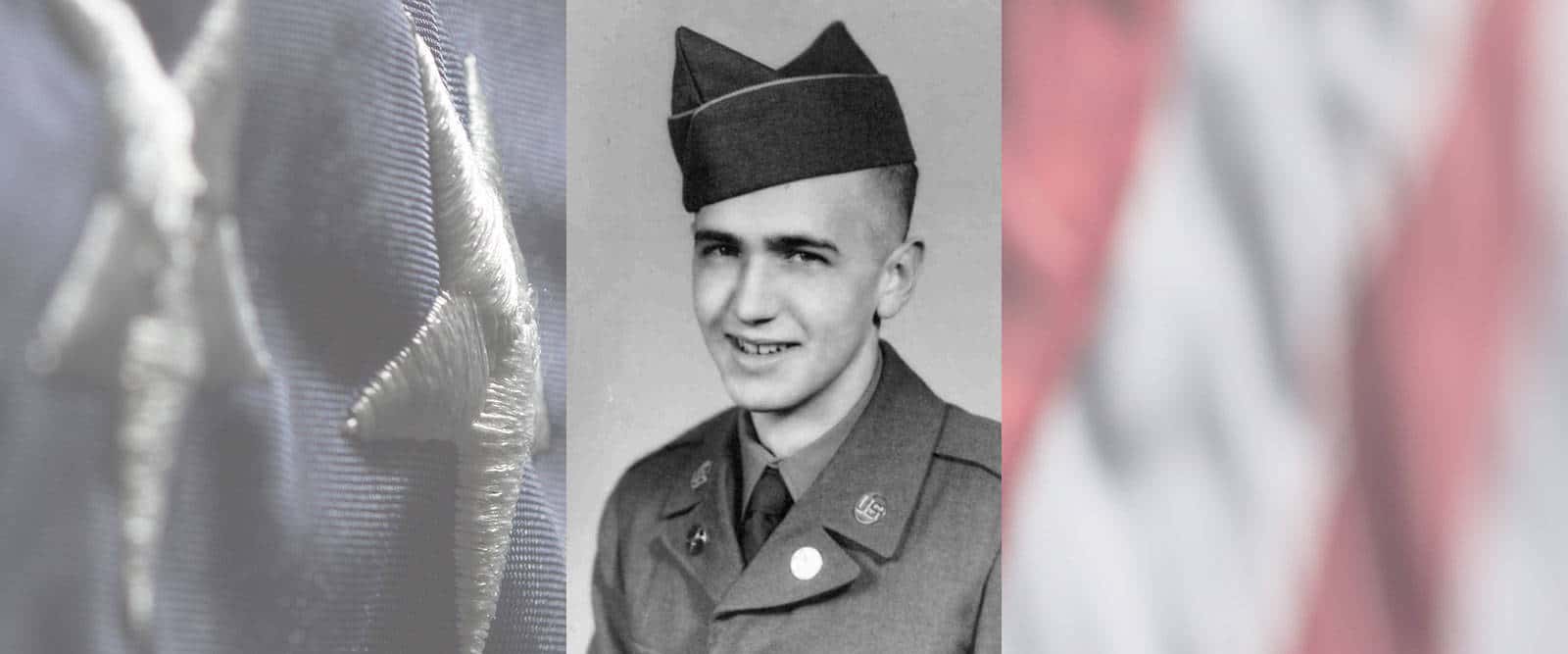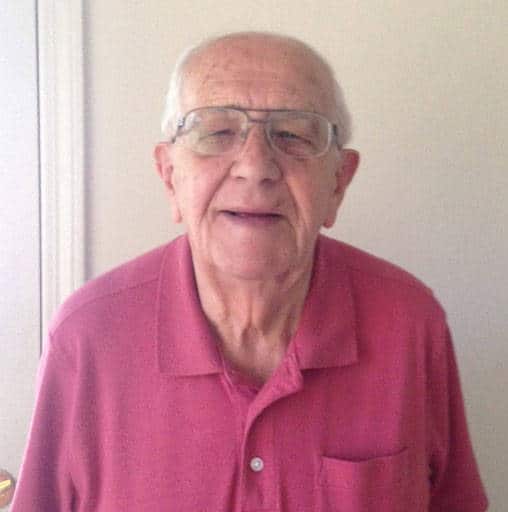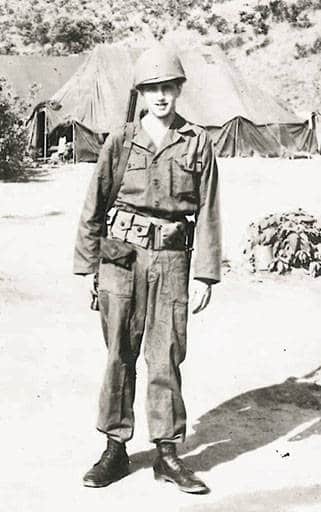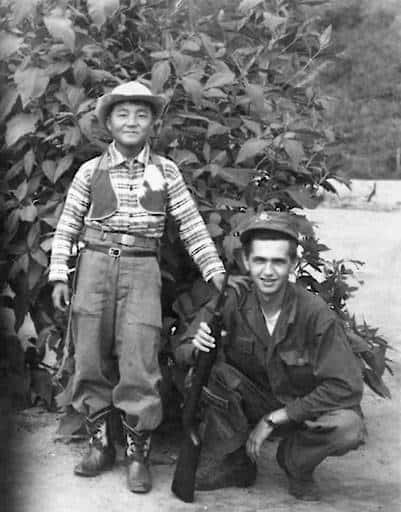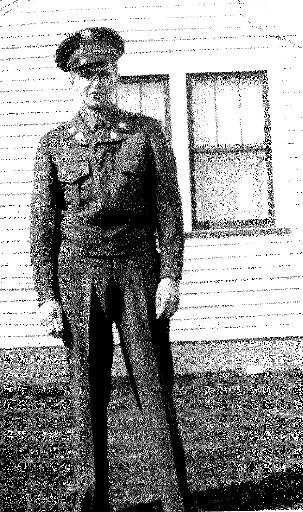U.S. Army Korean War Wheeling, IL Flight date: 09/13/17
By Jim Parker, Honor Flight Chicago Veteran Interviews Volunteer
Paul Loeffler was born in December 1928 in New Ulm, Minnesota. It was a pleasant community located Southwest of Minneapolis, known for its rich German heritage and culture. His father, a hardware salesman, along with Paul’s mother raised him and his five older siblings. Paul was active in sports, primarily baseball and football, and was a good student. So good in fact that by the end of his junior year, at only 16 years of age, he had earned enough credits to qualify for admission to St. John’s University in Collegeville, Minnesota.
After four years at St. John’s, Paul graduated with a double major in Economics and Finance and a minor in Philosophy. He went to work at a bank in Grand Forks, North Dakota, where he met Mary, his future wife. One day it occurred to Paul that he had failed to inform his draft board in New Ulm that he had relocated. Shortly after notifying his draft board of his current address, he was ordered to report for a pre-induction physical. On December 7, 1950, Paul stepped to the line, raised his right arm and was inducted into the U.S. Army. After 16 weeks of basic and advanced infantry training at Ft. Riley, Kansas, Paul was assigned to the Far East Command. He knew what that meant – Korea. After a short leave (that included a trip to Grand Forks to deliver an engagement ring to Mary), Paul got on a plane for Seattle. He then boarded a troop ship for a 6,000 mile boat ride to Japan. After being issued his combat uniform and equipment, he took another boat ride, this time ending up in the South Korean port city of Pusan. During the trip Paul’s unit received a variety of orders, but finally he was assigned to the 2nd Combat Engineer Battalion, part of the famous 2nd Infantry (“Indianhead”) Division.
It is important to note that during a period beginning about a month before Paul’s enlistment and continuing through the time he was in training, the 2nd Infantry Division was in the fight of its life. Chinese forces crossed the northern border of North Korea surprising large numbers of U.S. Marine and U.S. Army units, including the 2nd Infantry. At the time, they were only about 50 miles from the border. The Chinese attacked in great numbers and forced the US and some UN troops to withdraw to the south. The 2nd Combat Engineer Battalion was one of the units assigned to cover the rear and flanks of the retreating units. They did this by holding lines until the last possible moment, then retreating very fast to other lines, holding them then retreating again. They kept this up until US forces were back in South Korea, near the town of Wonju, where they dug in and held. By this time the entire 2nd Infantry was decimated. From its original strength of about 1,000 men, the 2nd Combat Engineers had been reduced to less than 300 and only a few officers. The others had all been killed, wounded or captured. Before it could again become an effective fighting force, the 2nd Infantry needed a lot of new equipment and replacement troops. One of these troops included Paul Loeffler.
Paul’s first assignment at Wonju was military personnel records clerk for Company D. Later he was appointed records clerk for the entire battalion consisting of four companies. This assignment involved maintaining the 201 File for each soldier assigned to the unit. This file contains a series of orders and documents related to, among other things, a soldier’s civilian and military education, deployment, MOS (Military Occupation Specialty), evaluations, promotions, weapons qualifications, NOK (Next of Kin) contact information, decorations and SGLV (Servicemembers’ Group Life Insurance) election and beneficiary designations. For the 2nd Engineer Battalion most of these important files were lost or damaged during the rapid retreat from the north. The loss of those files took on even greater importance considering the battalion’s 70% casualty rate. Paul spent many hours repairing and reorganizing damaged documents. In some cases, entire records had to be reconstructed based upon very limited information. At the same time, he created a great number of records for the newly arriving replacement troops.
After a few months, most of the 2nd Infantry units were close to full strength and went back on the offensive. This involved redeployment of the entire unit to a camp further north. Paul’s records, equipment and personal effects had to be packed and put on trucks for the trip. When Paul and his fellow soldiers arrived at their next camp, everything had to be unpacked and made ready for working and living in the new location. This took some time as life at the new location was a bit more primitive than the last. After a few improvements (such as the arrival of winter uniforms and cots to sleep in instead of on the ground in sleeping bags) life got better. Most of the time they had regular mail call and hot chow that was not too bad, except for the green powdered eggs. They lived and worked in tents unless they were near a hill from which a livable cave could be cut. Oil fired heaters worked well in keeping them comfortable in the cold Korean winters. They learned how to identify the contents of C-ration boxes by their ID number, how to improve the taste with special ingredients (like ketchup) and with whom they could negotiate a favorable trade (like getting “Hamburger Patties” in exchange for the notoriously bad “Ham and Butter Beans”). They learned that an aerosol can of bug spray could chill a can of warm beer quite rapidly. There were some special times too – such as the arrival of a care package from home. Paul recalls that on one occasion his Dad got a hold of a long, circular metal can used to hold prepared meat (like Spam). Just the right size for a bottle of Johnny Walker! His Dad packed it with sawdust to cushion the square bottle for the long trip from New Ulm to Korea then took the container to a local welder who soldered on a new lid before mailing. When the package arrived Paul opened it with great anticipation only to find that sawdust was not really a great cushioning material. The contents were just some broken glass a lot of sawdust that smelled like scotch. “I almost cried” tells Paul.
The 2nd Infantry redeployed two more times while Paul was in Korea each one further north and each one involving more enemy engagements. One of these was the battle of Heartbreak Ridge (made famous by a Clint Eastwood movie) in September and October, 1951. Three infantry regiments of the 2nd Infantry made repeated direct frontal assaults on enemy positions located on a series of hills that together made up Heartbreak Ridge. As the hills were taken after fierce fighting, the Chinese, using fresh troops and supplies brought in from surrounding positions, mounted ferocious nighttime counter attacks, often re-taking them. To cut off these supplies and replacements, the division commanders devised a plan to isolate the hills by bringing up tanks of the 72nd Tank Battalion along a narrow dirt road in the Mundung-ni Valley that separated Heartbreak Ridge from the surrounding positions. This road was heavily mined and not substantial enough to accommodate the large Sherman tanks of the 72nd. The 2nd Combat Engineers were ordered to clear the mines and rebuild the road. They accomplished their mission while under almost constant enemy fire and sustained very heavy casualties in doing so. The 72nd Tank Battalion and the ground assault regiments of the 2nd Infantry also sustained great losses but they finally took and held Heartbreak Ridge.
In the spring of 1952, Paul and his fellow soldiers began hearing rumors that they would be replaced. By May 1952, he had accumulated enough “points” to qualify for reassignment back to the US. After another week in Japan for out-processing (paperwork, new uniforms and packing up), Paul was shipped back to the US where he boarded a troop train to Camp McCoy near Tomah Wisconsin. He resumed his clerking duties until September, 1952 when Paul returned to Minneapolis and was discharged from active duty.
He first returned to New Ulm then went on to Grand Forks where he and Mary were married. Paul took a job at the Northwestern National Bank in Minneapolis. Then, in 1960, Paul left banking and joined Moore Business Forms, a large, national company. As time passed Moore relocated Paul to Iowa and eventually to Chicago. He and Mary resided in Buffalo Grove. After 30 years with Moore Paul retired in 1990. Paul and Mary played golf together every day for 25 years and stay close to their three children and four great grandchildren.
Honor Flight Chicago is honored and proud to welcome Paul Loeffler, American hero, aboard our September 13, 2017 flight.



